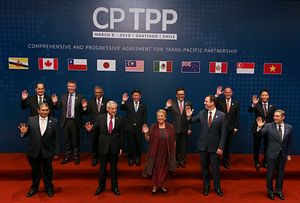The timing was highly ironic: just minutes after Asian trade ministers shook hands in Santiago on a region-wide free trade pact, U.S. President Donald Trump declared new tariffs on steel and aluminum imports in Washington, a move seen threatening a global trade war.
For a region still coming to grips with the protectionist Trump administration, Asia’s determination to push ahead with the Trans-Pacific Partnership (TPP) without the world’s biggest economy has sent a powerful message.
“The TPP-11 opens the door to a trade zone worth $13.7 trillion that spans the Americas and Asia,” Australian Trade Minister Steve Ciobo said Friday.
“As parts of the world flirt with protectionism, this is a timely reminder there is a different and better way to drive economic growth rather than stifle it.”
The so-called TPP-11 has retained most of the original trade pact signed in 2016 minus the involvement of the United States, which withdrew in January 2017 in one of Trump’s first acts as president.
Missing from the new pact were a number of provisions previously sought by U.S. negotiators, including pharmaceutical patent rules, investor-state dispute mechanisms, and reforms for state-owned enterprises.
Comprising more than 15 percent of world trade and 495 million people, the TPP-11 has brought together Australia, Brunei, Canada, Chile, Japan, Malaysia, Mexico, Peru, New Zealand, Singapore, and Vietnam in the world’s biggest new free trade zone. Had the United States stayed, the new deal would have represented 40 percent of global trade.
Nevertheless, after various twists and turns, including an aborted signing in late 2017, the pact was finally signed Thursday in the Chilean capital, coming amid “protectionist pressures… that could end up in what nobody wants, which is a trade war,” said Chilean Trade Minister Heraldo Munoz.
“We’re proud… to show the world that progressive trade is the way forward, that fair, balanced, and principled trade is the way forward, and that putting citizens first is the way forward for the world when it comes to trade,” Canadian Trade Minister François-Phillippe Champagne said.
The pact members reportedly aim to bring the agreement into force later this year, rather than in 2019 as originally planned. Under new rules, the TPP-11 will come into force just 60 days after six members ratify the deal.
“We are very hopeful like others that we will see the [new pact] coming into effect about the end of the year or shortly thereafter,” Australia’s Ciobo said.
New Members?
Australia, Chile, Japan, Mexico, New Zealand, and Peru are reportedly leading the charge for ratification, together with potentially Vietnam, according to Japan’s Nikkei.
In addition to the pact’s existing signatories, other Asian economies — including Indonesia, the Philippines, South Korea, Taiwan, and Thailand — have also expressed interest in joining, along with Colombia and the United Kingdom
With the pact leaving the door open for new signatories, including the United States, the potential benefits of the trade deal could expand well beyond its creators’ original expectations.
In January, Trump indicated at the World Economic Forum that the United States could return to the pact if offered a better deal, although he expressed his preference for bilateral as opposed to multilateral agreements.
Trump’s opposition has come despite a push by Republican senators for him to “re-engage with the Trans-Pacific Partnership.” U.S. farmers have also lobbied Washington to return to the pact, with U.S. Wheat Associates president Vince Peterson telling Australian media that being left out was “disastrous for our industry.”
Australian industry groups suggest the new TPP could boost Australian exports by 30 billion Australian dollars (US$23.6 billion) and increase real gross domestic product (GDP) by AU$18 billion by 2030, according to the Australian Financial Review.
Moody’s Investors Service has declared Malaysia one of the biggest winners, as the trade pact gives it access to new markets, including Canada, Mexico, and Peru, for its palm oil, rubber and electronics exports.
Japanese consumers have also gained access to cheaper Australian beef along with more inexpensive wine from Australia, Chile, and New Zealand, although the gains would have been greater with U.S. involvement. Tokyo played a key role in pushing through the pact, which Japanese Prime Minister Shinzo Abe has viewed as strengthening “Abenomics” reforms in the world’s third-largest economy.
The U.S. Peterson Institute for International Economics has pointed to prospective real income gains for the 11 signatories of around 1 percent of GDP “above a baseline of $158 billion, or a little less than half of the expected gains from the original deal for the 11 countries.”
However, the biggest loser is the United States, the Washington-based institute said. Under the original deal, U.S. real income would have risen by $131 billion a year, or 0.5 percent of GDP.
“Under the new deal without U.S. participation, the United States not only forgoes these gains but also loses an additional $2 billion in income because U.S. firms will be disadvantaged in the TPP markets,” said the institute’s Jeffrey J. Schott.
“One irony is that with this agreement, CPTPP countries remain committed to the comprehensive trade rules that the United States drafted and delivered in the original TPP, largely based on U.S. standards and practice, even though the Trump administration has walked away from the U.S.-designed agreement,” he added.
“In that sense, the 11 countries today reaffirmed their commitment to free and open markets, in contrast to the interventionist policies now advocated and implemented by their big neighbors, China and the United States!”
As the world contemplates the risks of rising protectionism, Asia’s leaders have demonstrated that free trade is far from finished.

































